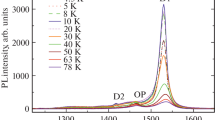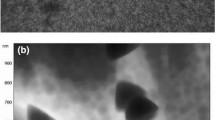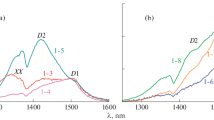Abstract
The complex research of the structure and electronic properties of defects occurring on the bonding border of twist misfit Si(001) wafers of n-type conductivity was carried out by the methods of transmission electron microscopy, deep level transient spectroscopy (DLTS), and photoluminescence. The revealed defects main are two types of dislocation structure: the orthogonal dislocation network composed of two screw dislocation families and zigzag mixed dislocations. The dislocation structures observed are the sources of intense luminescence, whose spectrum differ considerably from the standard dislocation luminescence spectrum at all investigated misfit angles of bonded Si wafers. It is shown that an increase of the misfit angle results in a strong transformation of the dislocation luminescence spectra consisting in the changes of the spectra form and a decrease in the integral luminescence intensity. In the studied samples, by means of the deep level transient spectroscopy method, the presence of deep centers whose concentration increases with an increase of the misfit angle of the bonded wafers is revealed. It is established that the deep centers are related to the dislocation structures observed by means of transmission electron microscopy.
Similar content being viewed by others
References
Kveder, V., Badylevich, M., Steinman, E., Izotov, A., Seibt, M., and Schröter, W., Silicon light emitting diodes based on dislocation luminescence, Appl. Phys. Lett., 2004, vol. 84, no. 12, pp. 2106–2108.
Vdovin, V., Vyvenko, O., Ubyivovk, E., and Kononchuk, O., Mechanisms of dislocation network formation in Si(001) hydrophilic bonded wafers, Solid State Phenom., 2011, vols. 178–179, pp. 253–258.
Wilhelm, T., Mchedlidze, T., Yu, X., Arguirov, T., Kittler, M., and Reiche, M., Regular dislocation networks in silicon. Part I: Structure, Solid State Phenom., 2008, vols. 131–133, pp. 571–578. doi:10.4028/www.scientific. net/SSP.131-133.571
Rouviere, J.L., Rousseau, K., Fournel, F., and Moriceau, H., Huge differences between lowand highangle twist grain boundaries: The case of ultrathin (001) Si films bonded to (001) Si wafers, Appl. Phys. Lett., 2000, vol. 77, no. 8, pp. 1135–1137. doi:10.1063/1.1289656
Reiche, M., Dislocation networks formed by silicon wafer direct bonding, Mater. Sci. Forum, 2008, vol. 590, pp. 57–78. doi:10.4028/www.scientific.net/MSF.590.57
Mchedlidze, T., Wilhelm, T., Yu, X., Arguirov, T., Jia, G., Reiche, M., and Kittler, M., Regular dislocation networks in Si. Part II: Luminescence, Solid State Phenom., 2008, vols. 131–133, pp. 503–510. doi:10.4028/ www.scientific.net/SSP.131-133.503
Steinman, E., Tereshchenko, A., Kononchuk, O., and Vdovin, V., Modification of dislocation PL centres due to misfit of bonded Si wafers, Phys. Status Solidi C, 2013, vol. 10, no. 1, pp. 16–19.
Steinman, E.A., Kononchuk, O., Tereshchenko, A.N., and Mazilkin, A.A., Dependence of luminescence properties of bonded Si wafers on surface orientation and twist angle, Solid State Phenom., 2010, vols. 156–158, pp. 555–560.
Bondarenko, A., Vyvenko, O., Kolevatov, I., Isakov, I., and Kononchuk, O., Dislocation structure, electrical and luminescent properties of hydrophilically bonded silicon wafer interface, Solid State Phenom., 2011, vols. 178–179, pp. 233–242.
Wagener, M.C., Zhang, R.H., Zhao, W., Seacrist, M., Ries, M., and Rozgonyi, G.A., Electrical uniformity of direct silicon bonded wafer interfaces, Solid State Phenom., 2008, vols. 131–133, pp. 321–326. doi:10.4028/ www.scientific.net/SSP.131-133.321
Dozsa, L., Szentpali, B., Pasquariello, D., and Hjort, K., Point defects generated by direct-wafer bonding of silicon, J. Electron. Mater., 2002, vol. 31, no. 2, pp. 113–118.
Cavalcoli, D., Cavallini, A., and Gombia, E., Defect states in plastically deformed n-type Silicon, Phys. Rev. B, 1997, vol. 56, no. 16, pp. 10208–10214.
Kveder, V. and Kittler, M., Dislocations in silicon and D-band luminescence for infrared light emitters, Mater. Sci. Forum, 2008, vol. 590, pp. 29–56.
Kveder, V., Orlov, V., Khorosheva, M., and Seibt, M., Influence of the dislocation travel distance on the DLTS spectra of dislocations in Cz-Si, Solid State Phenom., 2008, vols. 131–133, pp. 175–181.
Author information
Authors and Affiliations
Corresponding author
Additional information
Original Russian Text © A.N. Tereshchenko, E.A. Steinman, A.A. Mazilkin, M.A. Khorosheva, O. Kononchuk, 2014, published in Izvestiya Vysshikh Uchebnykh Zavedenii. Materialy Elektronnoi Tekhniki, 2014, No. 2, pp. 143–147.
Rights and permissions
About this article
Cite this article
Tereshchenko, A.N., Steinman, E.A., Mazilkin, A.A. et al. Structures and electronic properties of defects on the borders of silicon bonded wafers. Russ Microelectron 44, 585–589 (2015). https://doi.org/10.1134/S1063739715080107
Received:
Published:
Issue Date:
DOI: https://doi.org/10.1134/S1063739715080107




